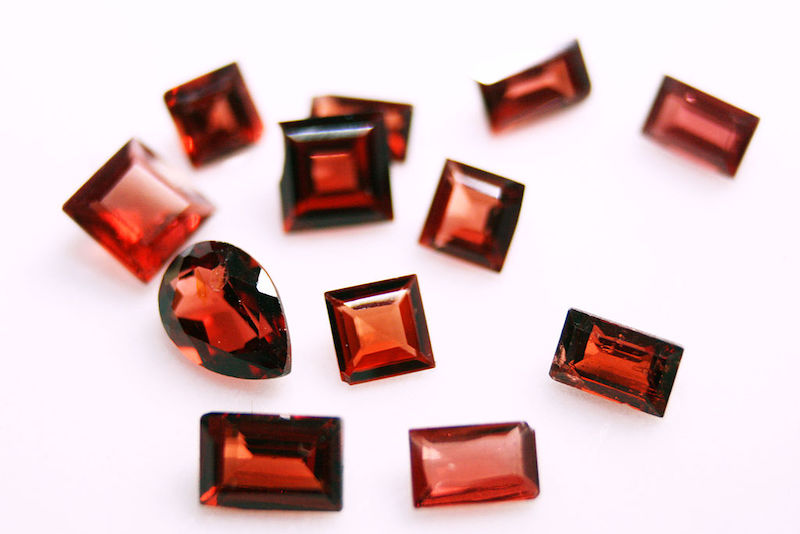
If you were born in January, the garnet is your birthstone.
People often think of garnets as red gemstones. In reality, garnets come in a variety of colors. They come from around the world, and people have used them as jewelry since the Bronze Age. Most garnets mined today are not gem-quality stones. Instead, they’re used in industry, primarily as abrasives. Only those with the right size, color and clarity are cut to make splendid gemstones.
The name garnet originated from the Latin granatus meaning seed. It may be a reference to the pomegranate, because small garnet crystals resemble the pomegranate’s red seeds.

Characteristics of the January birthstone, garnet
Garnets are a group of silicate minerals that occur with slightly different chemical compositions. Depending on the environment where they formed, garnet crystals may contain varying amounts of calcium, magnesium, iron, manganese, aluminum and chromium. As a result of these differences, garnets come in different colors, opacities, and a hardness range of 6.0 to 7.5 on the Mohs scale.
Most garnets form when sedimentary rock, like shale, undergoes metamorphosis, that is, the rocks are structurally changed when subjected to tremendous heat and pressure. Such conditions happen where tectonic plates converge. In these conditions, minerals recrystallize into forms that are more stable in that high temperature and pressure environment. Some become garnets. To a lesser extent, garnets are also found in igneous rocks such as granite.
Because garnets are hard, they largely retain their shape when weather erodes the metamorphic and igneous rocks they crystallized in. They end up in sediment that becomes soil, sand or sedimentary rock. Miners get garnets from these formations because it’s easier to extract the crystals. Almost half of the world’s supply comes from Australia. Other major sources are India, China and the United States.
Garnets come in many colors
Garnets can come in different colors due to the presence of certain elements. Almandine has iron and aluminum, resulting in deep red, brownish-red and black crystals. Pyrope garnets are red due to magnesium and aluminum. Spessartine has manganese and aluminum that give it an orange color. Grossular contains calcium and aluminum that produces mostly green crystals but also cinnamon-brown, red and yellow. Andradite garnets are red, yellow, brown and green due to calcium and iron. Uvarovite is a rare calcium chromium garnet variety that produces bright green gems.
Garnets occur in a range of opacities, from completely opaque to transparent. Some garnets contain inclusions – tiny bits of other rocks – that reflect light to create a star-like pattern in the stone. Inclusions can also cause the gemstone to appear to change colors under different lighting conditions.

Garnets in history
People have used garnets since the Bronze Age. Archaeologists discovered red garnet jewelry in the tombs of Egyptian pharaohs dating to 3100 BCE.
Ancient Greeks and Romans also prized the gems. They wore garnet jewelry, including carved garnets on signet rings used to stamp wax seals on documents.
In Staffordshire, England, a man using a metal detector discovered a large collection of Anglo-Saxon gold and silver metalwork in 2009. Known as the Staffordshire hoard, the artifacts date to the 6th and 7th century. They include 3,500 pieces of garnet cloisonné jewelry.
Around the start of the 16th century, the discovery of garnet deposits in Bohemia (in current-day Czech Republic) set off a thriving garnet jewelry industry in Europe. The gemstone remained popular through Victorian times until interest declined at the turn of the 20th century.

Mythology behind the January birthstone
Much of the early history and mythology of garnets intertwines with other red gemstones such as rubies and spinels. Ancient jewelers were often unable to distinguish between these red gems, which they called carbuncles.
Garnets are associated with many myths. Ancient warriors believed garnets brought victory. The Crusaders used them as protection against wounds and accidents during their journeys. In contrast, ancient Asian warriors believed that glowing garnets, used as bullets, inflicted more severe wounds. In 1892, during hostilities on the Kashmir frontier, the Hanza tribesmen fired on British soldiers with garnet bullets, believing them more effective than lead.
As with many precious stones, people once believed garnets held medicinal powers. In medieval times, people thought garnets protected its wearer against poisons, wounds and bad dreams, and that they cured depression. They used red garnets to relieve fever and yellow garnets to treat jaundice.

Learn about the birthstones for other months of the year:
January birthstone
February birthstone
March birthstone
April birthstone
May birthstone
June birthstone
July birthstone
August birthstone
September birthstone
October birthstone
November birthstone
December birthstone
Bottom line: January’s birthstone is the garnet. While the most familiar color is red, garnets also come in yellow, green, orange, brown and black.
The post January birthstone: the garnet first appeared on EarthSky.
0 Commentaires